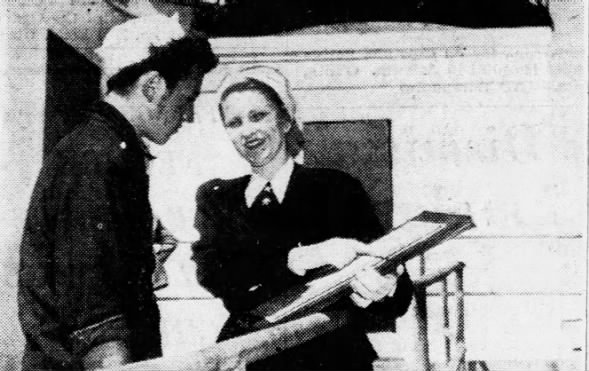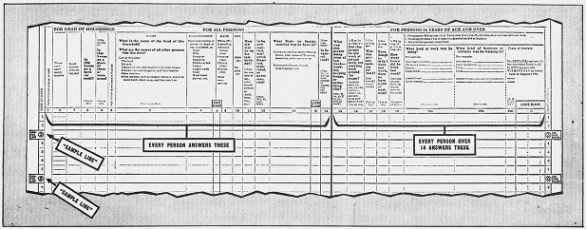The 1950 U.S. Census was released earlier this year, opening new avenues of research for family historians. Have you had the chance to search the census for your family members yet? Locating their names in the census isn’t the end of your journey—it’s just the beginning! If you pair the information you find in the census with newspaper searches, you might uncover things about your family members that you never knew.
Here are some ideas of ways to use Newspapers.com™ to learn even more from the 1950 census!
 Filling out the 1950 census 31 Mar 1950, Fri Arizona Republic (Phoenix, Arizona) Newspapers.com
Filling out the 1950 census 31 Mar 1950, Fri Arizona Republic (Phoenix, Arizona) Newspapers.com
Questions for all persons
Questions 1 & 2: Address
“Name of street, avenue, or road”; “House and apartment number”
- Search Newspapers.com™ for the street address where your relative lived in 1950. Newspapers of the era included people’s addresses much more often than they do today. You may find news stories, classified ads, legal notices, photos, and more in the local paper that mention your relative’s address. Start by narrowing your newspaper search to the years that your family member lived at the address, but then try broadening the date range to see if it returns other useful matches.
- If searching for the street number and name doesn’t return matches, try searching the local papers for just the street name to learn what was going on in your relative’s neighborhood that may have affected them.
- Look at newspaper real estate ads from the area to learn what homes looked like and what they cost.
Question 4: Farm
“Is this house on a farm or ranch?”
- If the census indicates that your relative lived on a farm, search their local newspaper to see if they are mentioned in notices of land transfers or sales. Your relative might also be mentioned in newspaper ads for crops or livestock.
- Browse papers from the area for news about weather conditions or natural disasters that would have affected your family member’s farm. Or read articles about local and national agricultural regulations and legislation in effect at the time.
Question 7 & 8: Name & Relationship
“What is the name of the head of this household?” “What are the names of all other persons who live here?” “Relationship of person to head of the household”
- People didn’t always give their legal name to the census taker—some may have provided a nickname or initials, for example, or the census taker may have written down an abbreviation of their name. If this is the case for your relative, search newspapers using the name variation used on the census to see if you get new matches.
- If your family member’s name was misspelled on the census, try searching Newspapers.com™ using the same misspelling. If the census taker got it wrong, the newspaper may have as well!
- Search newspapers for the names of other people listed in your relative’s household on the census. This can help you find obituaries and marriage announcements you may not have been able locate before, since family members are often named in these types of newspaper items.
- Don’t forget to do a newspaper search for the names of any boarders or renters listed in your relative’s household. They might be strangers, but they could also be related. Don’t discount them just because they have a different last name.
- Since extended family sometimes lived near each other, skim through prior and subsequent pages of the census to see if you spot any familiar last names. If you do, it might be worth a newspaper search to see if you can determine whether they are indeed related.
Question 11: Age
“How old was he on his on last birthday?”
- Knowing the person’s approximate age in 1950 can help you estimate a birth year, which will help you more easily locate newspaper birth announcements.
- Based on their age in 1950, you can also determine if your relative would have been eligible for military service in World War II (or World War I). Many men and women who served in the military or its auxiliaries were mentioned in their local paper when they enlisted, were wounded, were discharged, etc.
Question 12: Marital Status
“Is he now married, widowed, divorced, separated, or never married?”
- Knowing the person’s marital status (married, widowed, divorced, or separated) at the time of the census can alert you to types of newspaper content to look for. If you learn they were married, you now know to look for engagement and wedding announcements. If widowed, you know to look for a spouse’s obituary. If divorced, you know to look for divorce notices or news of legal proceedings.
Question 13: Birth location
“What State (or foreign country) was he born in?”
- This information can help you narrow your newspaper search to a particular location to improve the likelihood of finding a birth announcement.
- If the census notes that your relative was born in a different state, newspapers may be able to help you determine when and why they moved.
- If the person was born in a different country, newspapers can sometimes shed light on the details of their immigration journey.
 Newspaper publishes example of a 1950 census form 02 Apr 1950, Sun Arizona Republic (Phoenix, Arizona) Newspapers.com
Newspaper publishes example of a 1950 census form 02 Apr 1950, Sun Arizona Republic (Phoenix, Arizona) Newspapers.com
Questions for persons fourteen years of age and over
Question 15 & 20: Work
“What was this person doing most of last week: working, keeping house, or something else?” “What kind of work was he doing?” “What kind of business or industry was he working in?”
- If the census lists a specific employer, search Newspapers.com™ for the business name to see what you can learn about your family member’s work life through news articles or ads.
- If only a general industry is written on the census, look for articles about that industry, especially in the same town or region. Were there any on-going strikes at the time, for example? You can also look at business ads, classifieds, help-wanted ads, and more to get a sense of the local economy.
- If your relative is listed as “keeping house,” try looking through the Home or “Women’s” sections of local newspapers to see what their daily life may have been like. What home appliances appeared in ads? What questions were being asked in home-advice columns, and what tips were being given? What recipes were popular? What was on sale at the local grocery store?
Questions for persons on sample lines (six per sheet)
Questions 21–24: Residence
“Was he living in this same house a year ago?” “Was he living on a farm a year ago?” “Was he living in this same county a year ago?” “If No: What county and State was he living in a year ago?”
- If the census says that your relative moved within the past year, try expanding the location of your newspaper searches to see if news about that person can be found in places other than the area where they were currently living.
- You can also use newspapers to try to determine why they moved. Maybe you’ll find a wedding announcement that indicates they were newly married. Or a newspaper photo of a graduating class that reveals they recently finished school and may have started a new job.
Questions 26–28: School
“What is the highest grade of school that he has attended?” “Did he finish this grade?” “Has he attended school at any time since February 1st?”
- If your relative was attending school, keep an eye out for their name in newspaper write-ups about scholastic awards, school sports, etc. You might even find them in a class photo!
- Look up school lunch menus published in newspapers from the time to see what was offered in the cafeteria. Or browse through back-to-school ads to see what was in fashion.
- If you can determine which school your family member attended, search newspapers for the school name to see if it was the subject of any news articles.
 1950 census form example with sample line questions 02 Apr 1950, Sun Arizona Republic (Phoenix, Arizona) Newspapers.com
1950 census form example with sample line questions 02 Apr 1950, Sun Arizona Republic (Phoenix, Arizona) Newspapers.com
Questions for persons on sample lines fourteen years of age and over (six per sheet)
Questions 31 & 32: Income
“Last year (1949), how much money did he earn working as an employee for wages or salary?” “Last year (1949), how much money did his relatives in this household earn working for wages or salary?”
- Based on the income listed in the census for your relative, look at the ads in their local paper to see what food, clothing, home goods, entertainment, transportation, etc., they may have been able to afford.
Question 33: Military Service
“If male, did he ever serve in the U.S. Armed Forces during World War I, World War II, any other time including present service?”
- If the census says that your family member served in the armed forces during World War I or World War II, you may be able to find news about them from the war years (e.g., enlistment, discharge, etc.). Or you may find a photo of them in their uniform.
- If you are able to determine what unit your relative served with, you can look for newspaper accounts of the battles they fought in to better understand their wartime experience. (Don’t forget to search beyond the war years too, as some veterans didn’t share their stories until much later.)
Questions for person on the last sample line if fourteen years of age and over (one per sheet)
Question 35: Previous Employment
“What kind of work did this person do in his last job?” “What kind of business or industry did he work in?”
- Newspapers may be able to help you determine why your family member changed jobs. Did the industry they worked in experience layoffs? Was your relative injured on the job? News stories with this information may have appeared in the paper.
Questions 36 & 37: Previous Relationships
“If ever married: Has this person been married more than once?” “How many years since this person was (last) married, widowed, divorced, separated?”
- This information on the census lets you know to search for announcements for previous marriages, for divorce notices, for spouse obituaries, etc. If a woman was married more than once, keep in mind that she may have appeared in the newspaper with a different surname or under a different husband’s name or initials (“Mrs. John A. Smith” or “Mrs. J. A. Smith”).
Search Newspapers.com™ today to see what you can discover about your family’s story! For more content like this, follow us on Facebook, Twitter, Instagram, and TikTok!

